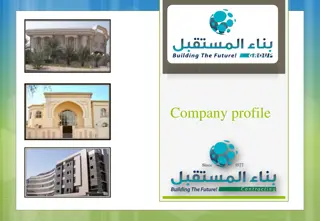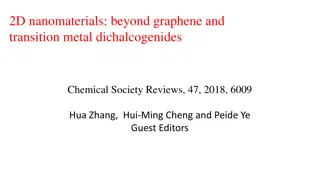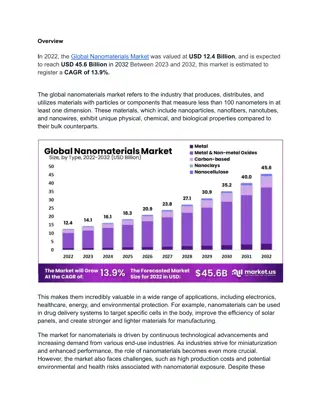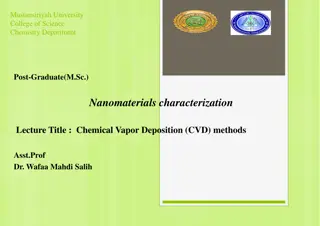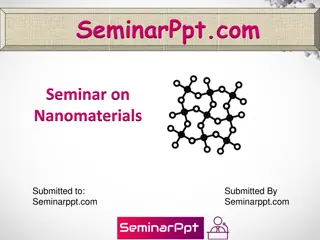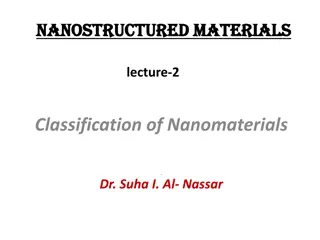Advancements in Nanomaterials for Building Construction
Addition of nanoscale materials like nano-SiO into cement can enhance compressive strength and pore size distribution in concrete. Carbon nanotubes offer mechanical durability and crack prevention in construction materials. However, the use of nanomaterials in construction is currently limited due to reasons such as lack of knowledge, standards, product availability, high costs, health risks, and the need for further research and development. To expand the use of nanomaterials, critical steps include selecting suitable nanomaterials, studying their characteristics, analyzing building elements under different loads, and establishing design and construction standards.
Download Presentation

Please find below an Image/Link to download the presentation.
The content on the website is provided AS IS for your information and personal use only. It may not be sold, licensed, or shared on other websites without obtaining consent from the author.If you encounter any issues during the download, it is possible that the publisher has removed the file from their server.
You are allowed to download the files provided on this website for personal or commercial use, subject to the condition that they are used lawfully. All files are the property of their respective owners.
The content on the website is provided AS IS for your information and personal use only. It may not be sold, licensed, or shared on other websites without obtaining consent from the author.
E N D
Presentation Transcript
Nanomaterials for Building Nanomaterials for Building Dr. Raouf Mahmood
Nanomaterials for Building Nanomaterials for Building Addition of nanoscale materials into cement could improve its performance, It is found that nano-SiO could significantly increase the compressive for concrete, containing large volume fly ash, at early age and improve pore size distribution by filling the pores between large fly ash and cement particles at nanoscale. It has also been reported that adding small amount of carbon nanotube (1%) by weight could increase both compressive and flexural strength. When the microcapsules are broken by a crack, the healing agent is released into the crack and contact with the catalyst. The polymerization happens and bond the crack faces. The self healing polymer could be especially applicable to fix the micro cracking in bridge piers and columns. But it requires costly epoxy injection
Nanomaterials for Building Currently, the use of nanomaterials in construction is reduced, mainly for the following reasons: 1. The lack of knowledge concerning the suitable nanomaterials for construction and their behavior. 2. The lack of specific standards for design and execution of the construction elements using nanomaterials. 3. The reduced offer of Nano products. 4. The lack of detailed information's regarding the Nano products content; high costs. 5. The unknowns of health risks associated with nanomaterials. 6. The choice of nanomaterials with potential use in construction and the study of their characteristics. 7. The behavior study of the building elements that contain nanomaterials under various loads. 8. The development of specific design and construction standards.
Nanomaterials for Building In order to be able to use in the construction industry the nanomaterials at wide scale it is necessary that the researches to be conducted following the next stages: the choice of nanomaterials with potential use in construction . the study of their characteristics; the behavior. study of the building elements that contain nanomaterials under various loads. the development of specific design and construction standards.
Nanomaterials for Building 1. The Carbon Nanotubes Carbon: nanotubes are a form of carbon having a cylindrical shape, the name coming from their nanometre diameter. They can be several millimetres in length and can have one layer or wall (single walled nanotube) or more than one wall (multi walled nanotube). Nanotubes are members of the fullerene structural family and exhibit extraordinary strength and unique electrical properties, being efficient thermal conductors. For example, they have five times the Young s modulus and eight times (theoretically 100 times) the strength of steel, whilst being 1/6th the density. Expected benefits of carbon nanotubes are: mechanical durability and crack prevention in concrete, enhanced mechanical and thermal properties in ceramics and real-time structural health monitoring capacity.
Nanomaterials for Building 2. Titanium Dioxide Nanoparticles (TiO ) The titanium dioxide nanoparticles are added to concrete to improve its properties. This white pigment is used as an excellent reflective coating. Or added to paints, cements and windows for its sterilizing properties. The titanium dioxid breaks down organic pollutants, volatile organic compounds and bacterial membranes through powerful photo catalytic reactions, reducing air pollutants when it s applied to outdoor surfaces. Being hydrophilic gives self cleaning properties to surfaces to which it is applied, because the rain water is attracted to the surface and forms sheets which collect the pollutants and dirt particles previously broken down and washes them off. The resulting concrete surface has a white colour that retains its whiteness very effectively.
Nanomaterials for Building 3. Silicon Dioxide Nanoparticles (SiO ) Nano-SiO could significantly increase the compressive strength of concretes containing large fly ash volume at early age, by filling the pores between large fly ash and cement particles. Nano-silica decreases the setting time of mortar when compared with silica fume (micro silica) and reduces bleeding water and segregation by the improvement of the cohesiveness.
Nanomaterials for Building 4. Zinc Oxide Nanoparticles (ZnO) Zinc oxide is a unique material that exhibits semiconducting and piezoelectric dual properties. It is added into various materials and products, including plastics, ceramics, glass, cement, rubber, paints, adhesive, sealants, pigments, fire retardants. Used for concrete manufacturing, ZnO improves the processing time and the resistance of concrete against water.
Nanomaterials for Building 5. Silver Nanoparticles (Ag) The Nano silver will affect, in contact with bacteria, viruses and fungi, the cellular metabolism and inhibit cells growth. The Nano silver inhibits multiplication and growth of bacteria and fungi, which causes infection, odour, itchiness and sores. The core technology of Nano silver is the ability to produce particles as small as possible and to distribute these particles very uniformly. When the nanoparticles are coated on the surface of any material, the surface area is increasing several million times than the normal silver foil
Nanomaterials for Building 6. Aluminium Oxide Nanoparticles (Al O3) Alumina (Al2O3) component reacts with calcium hydroxide produced from the hydration of calcium silicates. The rate of the pozzolanic reaction is proportional to the amount of surface area available for reaction. The addition of nano-Al2O3 of high purity improves the characteristics of concretes, in terms of higher split tensile and flexural strength. The cement could be advantageously replaced in the concrete mixture with nano-Al2O3 particles up to maximum limit of 2.0% with average particle sizes of 15 nm, the optimal level of nano- Al2O3 particles content being achieved with 1.0% replacement.
Nanomaterials for Building 7. Zirconium Oxide Nanoparticles (ZrO ) Zirconium oxide (or Zirconia) Nano powder or nanoparticles are white high surface area particles with typical dimensions of 5 100 nanometres and specific surface area in the 25 50 m /g range. Nano zirconium shows good aesthetics (translucency), superior physical resistance (hardness, flexibility, (practically inert) and is a very good insulator. durability), chemical resistance
Nanomaterials for Building 8. Wolfram (Tungsten) Oxide Nanoparticles (WO3) In recent years, tungsten trioxide has been employed in the production of electro chromic windows, or smart windows. These windows are electrically switchable glass that change light transmission properties with an applied voltage. This allows the user to tint their windows, changing the amount of heat or light passing through.
Nanotechnologies for Construction Nanotechnology can generate products with many unique characteristics that can improve the current construction materials: lighter and stronger structural composites, low maintenance coatings, better cementitious materials, lower thermal transfer rate of fire retardant and insulation, better sound absorption of acoustic absorbers and better reflectivity of glass.
Nanotechnologies for Concrete Concrete is a macro-material strongly influenced by its nano-properties. The addition of nano-silica (SiO2) to cement based materials can control the degradation of the calcium-silicatehydrate reaction caused by calcium leaching in water, blocking water penetration and leading to improvements in durability. Nano-sensors have a great potential to be used in concrete structures for quality control and durability monitoring. (to measure concrete density and viscosity, to monitor concrete curing and to measure shrinkage or temperature, moisture, chlorine concentration, pH, carbon dioxide, stresses, reinforcement corrosion or vibration). Carbon nanotubes increase the compressive strength of cement mortar specimens and change their electrical properties which can be used for health monitoring and damage detection. The addition of small amounts (1%) of carbon nanotubes can improve the mechanical properties of mixture samples of Portland cement and water. Oxidized multi-walled nanotubes show the best improvements both in compressive strength and flexural strength compared to the reference samples.
Nanotechnologies for Steel The addition of copper nanoparticles reduces the surface unevenness of steel which then limits the number of stress risers and hence fatigue cracking, leading to increased safety, less need for monitoring and more efficient materials use in construction subjected to fatigue issues. Vanadium and molybdenum nanoparticles improve the delayed fracture problems associated with high strength bolts, reducing the effects of hydrogen embrittlement (hydride-forming metals) and improving the steel micro-structure. The addition of nanoparticles of magnesium and calcium leads to an increase in weld toughness. The carbon nanotubes have little application as an addition to steel because of their inherent slipperiness, due to the graphitic nature, making them difficult to bind to the bulk material. Also, the high temperatures involved in the steel elements production process enhances the vibration of carbon atoms significantly, leading to bond breaking and defects in the nanotubes structure.
Nanotechnologies for Wood Wood is composed of nanotubes or Nano fibrils . Lignocellulose surfaces at the nanoscale could open new opportunities for such things as self sterilizing surfaces, internal self-repair, and electronic lignocellulose devices, providing feedback for product performance and environmental conditions during service. Highly water repellent coatings incorporating silica and alumina nanoparticles and hydrophobic polymers are proper to be used for wood.
Nanotechnologies for Glass The use of TiO2 nanoparticles to glasses leads to so-called self cleaning technology. Due to the nanoparticles photo catalytic reactions, the organic pollutants, volatile organic compounds and bacterial membranes are decomposed. As well, TiO2 being hydrophilic, his attraction to water forms drops which then wash off the dirt particles decomposed in the previous process. Fire-protective glass is obtained using fumed silica (SiO2) nanoparticles as a clear interlayer sandwiched between two glass panels which turns into a rigid and opaque fire shield when is heated.
Nanotechnologies for Coatings and Paintings Nanotechnology is applied to paints in order to assure the corrosion protection under insulation since it is hydrophobic and repels water from the metal pipe and can also protect metal from salt water attack. Others applications refer to coatings that have self healing capabilities through a process of self-assembly . In addition to the self-cleaning coatings mentioned above for glazing, the remarkable properties of TiO2 nanoparticles are put to use as a coating material on roadways in tests around the world.
Nanotechnologies for Thermal Insulation Micro- and nonporous aerogel materials are appropriate for being core materials of vacuum insulation panels but they are sensitive to moisture. As a possible remedy it was produced an ultra-thin wall insulation which uses a hydrophobic nonporous aerogel structure. Another application of aerogels is silica based products for transparent insulation, which leads to the possibility of super-insulating windows. Micro- or Nano electomechanical systems offer the possibility of monitoring and controlling the internal environment of buildings and this could lead to energy savings.
Nanotechnologies for Fire Protection Fire resistance of steel structures is often provided by a coating produced by a spray-on cementitious process. Nano-cement (made of nanosized particles) has the potential to create a tough, durable, high temperature coatings. This is achieved by the mixing of carbon nanotubes with the cementious material to fabricate fibre composites that can inherit some of the outstanding properties of the nanotubes.
Nanotechnologies for Structural Monitoring Nano- and micro electrical mechanical systems (MEMS) sensors have been developed and used in construction to monitor and/or control the environment condition and the materials/structure performance. Nano sensor ranges from 10 9to 10 5m. These sensors could be embedded into the structure during the construction process and could monitor internal stresses, cracks and other physical forces in the structures during the structures life.
Reference Olar, Radu. "Nanomaterials and nanotechnologies for civil engineering." Buletinul Institutului Politehnic din lasi. Sectia Constructii, Arhitectura 57.4 (2011): 109.










